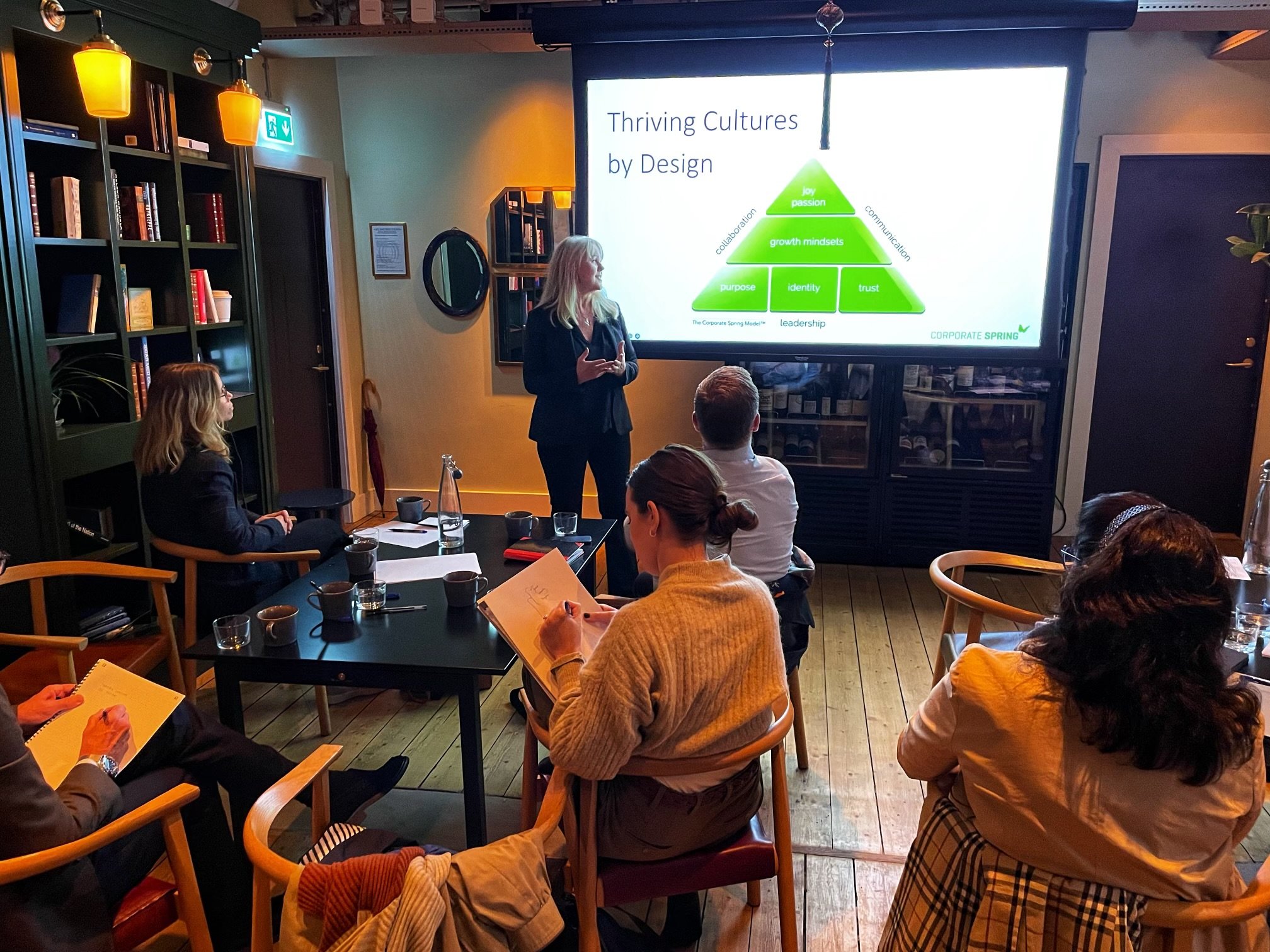The Corporate Spring Model™
After nearly 20 years of rigorous research and practical application in leading global corporations, we developed The Corporate Spring Model™ to offer our clients a practical framework for strategically building thriving, high-performing teams and future-ready organizations.
Rooted in neuroscience, psychology, and group dynamics, this holistic approach empowers leaders and teams to shape mindsets, behaviors, and habits that align with their purpose, values, strategies and goals. By recognising that organizational culture is a complex interplay of factors, our model offers a dynamic framework to effectively strengthen and evolve cultures, drive impactful change, and build sustainable, future-ready organizations.
The Corporate Spring Model™ is a powerful roadmap to strategically build the culture you need to succeed.
Having helped hundreds of leaders and teams worldwide implement the model with great success, we have seen the extraordinary results it can can create.
Clients see employee engagement increase with up to 13%, have significant improvements in Employee Net Promoter Scores, and experience new levels of collaboration, innovation, and business performance as a result of working strategically with their culture, guided by the Corporate Spring Model™.
“The Corporate Spring team provides deep knowledge, structure and processes into the not-so-tangible process of building, and continuously evolving, a strong culture. Without constantly securing those building blocks, a company will not survive in today´s fast-changing value-driven world. We are privileged and grateful to be guided by Corporate Spring on this exciting journey to form a culture where people thrive and thereby deliver on our purpose back to society. We are following the process mindfully and can clearly experience the impact in the organisation.”
– Henrik Holck-Clausen, Chief of Staff, Kyoto Group
The 5 Building Blocks
of Thriving, High-Performing Cultures
A compelling and inspiring purpose gives employees a sense of direction and meaning, fueling motivation and deepening engagement in their work. It serves as a guiding force that aligns teams, drives strategic decision-making, and inspires action at every level of the organization. A strong purpose not only unites employees around a shared vision but also attracts customers and partners who resonate with the company’s values and mission. When purpose is well-defined and authentically lived, it becomes a powerful catalyst for growth, innovation, and long-term success.
Purpose
A strong and distinct identity, rooted in clear values, or a “culture code” is the foundation of a thriving organizational culture. It fosters a sense of unity and belonging among employees, creating an environment where people feel connected and inspired to contribute their best. A well-defined identity serves as a compass for decision-making, shaping behaviors and reinforcing the company’s reputation. Moreover, it attracts stakeholders—employees, customers, and partners—who align with the company's values and beliefs, strengthening long-term relationships and driving sustainable success.
Identity
Trust
Trust is the cornerstone of a strong and resilient organization. It creates a foundation of reliability, transparency, and mutual respect, empowering employees to work with confidence and purpose. It is also the most difficult to build, and the easiest to lose. But when trust is present, open communication flourishes, collaboration strengthens, and psychological safety thrives—allowing teams to take risks, share ideas, and innovate without fear. A culture built on trust not only enhances performance but also fosters deeper connections, engagement, and lasting business impact.
Fostering a growth mindset within an organization is essential for cultivating a culture of continuous learning, resilience, and adaptability. When employees embrace a growth mindset, they see challenges as opportunities for growth, remain persistent in the face of setbacks, and proactively seek solutions rather than dwelling on problems. This mindset fuels innovation, drives progress, and empowers individuals and teams to adapt to change with confidence. By encouraging curiosity, feedback, and a commitment to learning, companies can unlock their full potential and stay ahead in a dynamic world.
Growth mindset
Infusing passion and joy into a company’s culture elevates employee well-being while driving creativity, productivity, and a deeper sense of purpose. When people find joy in their work and are passionate about the company’s mission, they become more motivated, collaborative, and committed to achieving shared goals. Research shows that teams and companies where employees are happy at work perform 50% better than less engaged organizations, are 23% more profitable, and experience 50% higher talent retention. A culture that celebrates passion and joy fosters a positive, energizing environment where individuals thrive, innovation flourishes, and long-term success is built on enthusiasm and fulfillment.
Passion & Joy
The 3 Drivers That Makes It Come to Life.
Leadership is essential for building thriving, high-performing cultures. But not just any leadership—the kind of leadership that inspires, energises, and makes people feel seen, valued, and respected.
The Corporate Spring Leadership Wheel™ guides your leadership journey, beginning with leading yourself. It starts with increasing self-awareness and understanding how who you are and what you do influence others. When you master self-leadership, you become better at leading others. And when you effectively lead others, they, in turn, contribute to building a thriving culture and a successful business.
Leadership
We communicate constantly—even when we’re not aware of it. Becoming a conscious communicator helps us navigate life and work more effectively, reducing misunderstandings along the way.
Communication is the foundation of a strong team culture, and by learning, discussing, and practicing it, you can build a highly effective and well-functioning team. Poor communication is often at the root of workplace challenges and crises. communication skills strengthen team dynamics, boost engagement, and drive productivity.
Communication
It’s through collaboration that we learn from one another, challenge perspectives, help each other grow and develop, and are able to create and build something that is much greater than the sum of its part.
True collaboration goes beyond simply working together—it’s about building meaningful connections, sharing knowledge, and leveraging diverse strengths to achieve something greater than what you could accomplish alone. A thriving, high-performing culture depends on people collaborating, trusting one another, and offering support to reach common goals and business success.




